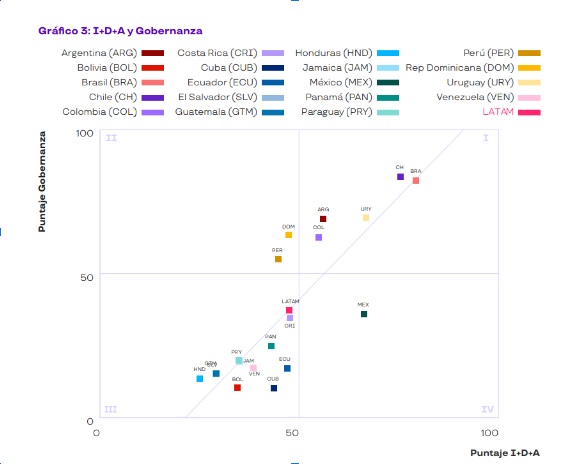Latin America and Artificial Intelligence: Chile, Brazil, and Uruguay lead the ILIA 2024 Index
October 3, 2024

The 2024 Latin American Artificial Intelligence Index (ILIA) has revealed its latest results, with Chile, Brazil, and Uruguay emerging as the top-ranking countries in the region. But what does this mean for Latin America, and how does it impact the development of artificial intelligence (AI) across the continent?
Led by Chile’s National Center for Artificial Intelligence (CENIA) and the Economic Commission for Latin America and the Caribbean (ECLAC), ILIA 2024 evaluated the readiness of 19 Latin American and Caribbean countries for AI adoption. The criteria included technological infrastructure, talent, scientific productivity, and governance. In this assessment, Chile scored 73.07 points, followed by Brazil with 69.30, and Uruguay with 64.98.
However, beyond the numbers, the report unveils trends, challenges, and opportunities that deserve a closer look.

What does ILIA 2024 reveal about AI in Latin America?
Artificial intelligence in Latin America is maturing, with some countries emerging as pioneers while others remain in the early stages of adoption. The good news is that the region has doubled its concentration of AI talent in the workforce over the past eight years. Yet, the region still lags behind the levels of more developed countries in the Global North. This reflects how AI is beginning to integrate into our economies and societies, but also highlights the challenges we face in keeping up with global advancements.
Human talent and brain drain, a regional challenge
When discussing the importance of AI talent, we are referring to the heart and brain driving innovation and development in this field. Without a skilled workforce trained in AI, a country’s ability to adapt to and lead the technological revolution is significantly limited. The ILIA 2024 report highlights the growing demand for professionals with AI skills and how this talent is essential to driving development and competitiveness in the region.
AI talent development goes beyond engineers and data scientists who create and train algorithms. It also includes professionals who use AI in their daily work and possess AI literacy. These are the individuals who not only design the technology but also apply it effectively across different sectors.
The report uses a metric based on the number of LinkedIn users who add AI skills to their profiles or work in AI-related occupations to measure AI talent development. Known as the “AI talent concentration,” this metric offers detailed insight into how AI talent is distributed across Latin America.
Since 2016, AI talent concentration has increased in nearly every country in the region, albeit at different rates. Costa Rica leads with the highest concentration of AI talent (0.18%), followed by Chile (0.15%), Uruguay (0.14%), Argentina (0.12%), and Mexico (0.11%). In contrast, countries like Bolivia (0.06%) and the Dominican Republic (0.06%) show lower concentrations, indicating a significant talent gap in the region.
While Costa Rica has tripled its AI talent concentration since 2016, reaching 0.18% in 2024, the region still falls far short of global leaders. Countries in the Global North, with more advanced industrial and productive capacities, have far higher AI talent concentrations than any Latin American country.
The implications of these data are clear: as AI applications and technologies expand, so does the demand for specialized talent. The region must intensify its efforts to train and retain this talent to remain globally competitive. Latin American countries have the potential to become AI innovation hubs, but this will depend largely on their ability to develop and nurture the professionals who will lead this technological revolution.
This challenge isn’t unique to one country; it’s a regional reality that forces us to ask: How can we retain and attract our top talent to drive AI development in our countries?

Infrastructure and computing capacity: the foundations of AI
When we talk about infrastructure in the context of artificial intelligence, we’re not just referring to computers and servers; we’re talking about the technological support a country needs to create an environment where AI can thrive. ILIA 2024 considers infrastructure as a critical factor that directly contributes to the development and implementation of AI technologies in the region.
To excel in this area, a country must have key elements in place, such as a large number of high-capacity servers for data storage and processing, access to cloud computing, high-performance computers, high-speed networks, and platforms that enable the development and deployment of AI applications. Additionally, internet connectivity and access to devices with good connections are fundamental aspects of fostering technological development.
In the ILIA 2024 report, the infrastructure subdimension is seen as one of the main drivers of digitalization and represents 45% of the total weighting for the “Enabling Factors” dimension. Three key indicators—Connectivity, Computing, and Devices—form the backbone of any digital ecosystem.
For instance, a nation with an extensive fiber-optic network, available 5G connections, and a high number of data centers with cutting-edge servers has a strong infrastructure, offering fertile ground for AI development. Infrastructure is like the highway through which AI data and applications travel, and the more modern and efficient that highway, the faster and more effective the country’s AI development will be.
Uruguay leads in infrastructure with 67.90 points, closely followed by Chile (67.58) and Costa Rica (55.86), according to ILIA 2024. These countries have made significant investments in their technological infrastructure, allowing them to develop an environment conducive to AI innovation and growth.
Without solid infrastructure, it’s difficult for any country to fully harness the potential of AI. It’s like trying to run a marathon with untied shoelaces; you might reach the finish line, but it will be much harder.
Governance and ethics: the role of regulation
Governance is another key pillar of AI development. Countries like Chile have shown a high level of development in this area, establishing policies and regulatory frameworks that promote the ethical and responsible adoption of AI. Other countries, like Mexico, perform well in research, development, and adoption, but still have room to improve in governance.
Governance is not just about creating laws and regulations; it’s about ensuring that AI is used in a way that benefits society as a whole and doesn’t deepen existing inequalities.
AI as a driver of development and entrepreneurship
The ILIA 2024 report also shows that the more industrialized and globally competitive countries, such as Mexico and Brazil, have higher patenting rates, more high-tech workers, and a greater number of unicorn companies and cutting-edge technology manufacturers. Meanwhile, Chile, Uruguay, and Costa Rica stand out for their entrepreneurial environments, private investment, and the emergence of AI startups.
This dynamism in creating AI-based companies is an encouraging sign that the region is beginning to see artificial intelligence not just as an innovation tool but also as a driver of economic development.
An opportunity for the entire region
ILIA 2024 is not only a recognition of the countries leading in AI but also a call to the entire region to seize this technological revolution. AI has the potential to transform sectors such as education, healthcare, and the environment, and it could be key to boosting Latin America’s economic development.
However, for this to become a reality, countries must work together, share knowledge and experiences, and develop policies that drive investment, education, and infrastructure in AI.




